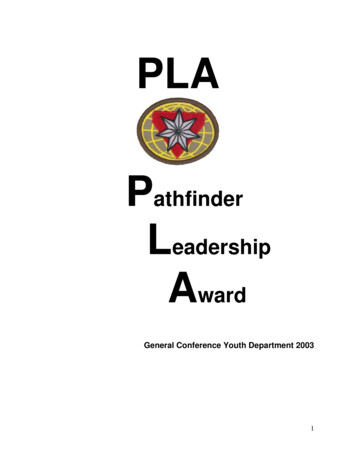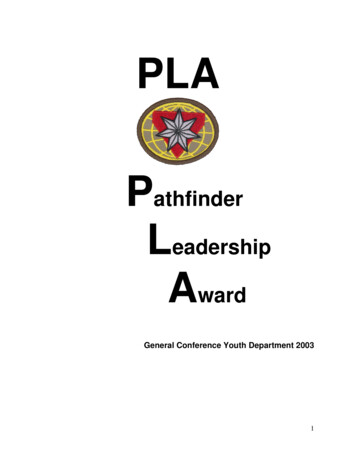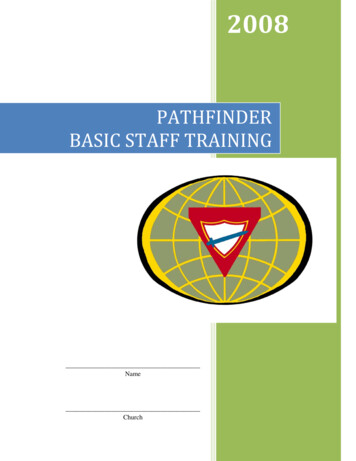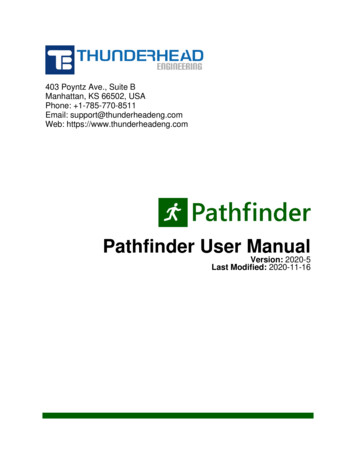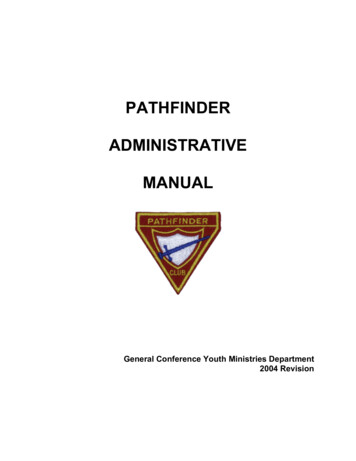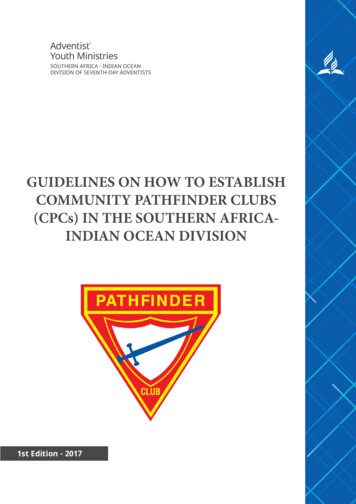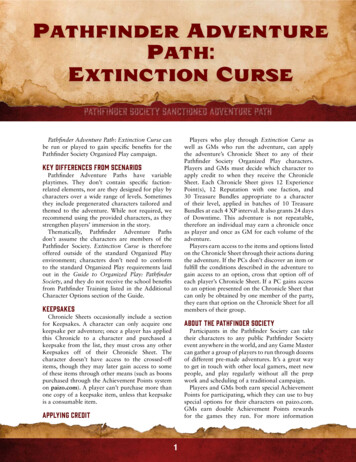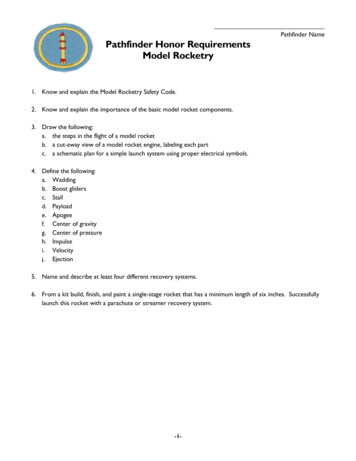
Transcription
Pathfinder NamePathfinder Honor RequirementsModel Rocketry1. Know and explain the Model Rocketry Safety Code.2. Know and explain the importance of the basic model rocket components.3. Draw the following:a. the steps in the flight of a model rocketb. a cut-away view of a model rocket engine, labeling each partc. a schematic plan for a simple launch system using proper electrical symbols.4. Define the following:a. Waddingb. Boost glidersc. Stalld. Payloade. Apogeef. Center of gravityg. Center of pressureh. Impulsei. Velocityj. Ejection5. Name and describe at least four different recovery systems.6. From a kit build, finish, and paint a single-stage rocket that has a minimum length of six inches. Successfullylaunch this rocket with a parachute or streamer recovery system.-1-
NAR Model Rocket Safety Code1. Materials. I will use only lightweight, non-metal parts for the nose, body, and fins of my rocket.2. Motors. I will use only certified, commercially-made model rocket motors, and will not tamper with thesemotors or use them for any purposes except those recommended by the manufacturer.3. Ignition System. I will launch my rockets with an electrical launch system and electrical motor igniters. Mylaunch system will have a safety interlock in series with the launch switch, and will use a launch switch thatreturns to the "off" position when released.4. Misfires. If my rocket does not launch when I press the button of my electrical launch system, I will removethe launcher's safety interlock or disconnect its battery, and will wait 60 seconds after the last launchattempt before allowing anyone to approach the rocket.5. Launch Safety. I will use a countdown before launch, and will ensure that everyone is paying attention andis a safe distance of at least 15 feet away when I launch rockets with D motors or smaller, and 30 feet whenI launch larger rockets. If I am uncertain about the safety or stability of an untested rocket, I will check thestability before flight and will fly it only after warning spectators and clearing them away to a safe distance.6. Launcher. I will launch my rocket from a launch rod, tower, or rail that is pointed to within 30 degrees ofthe vertical to ensure that the rocket flies nearly straight up, and I will use a blast deflector to prevent themotor's exhaust from hitting the ground. To prevent accidental eye injury, I will place launchers so that theend of the launch rod is above eye level or will cap the end of the rod when it is not in use.7. Size. My model rocket will not weigh more than 1,500 grams (53 ounces) at liftoff and will not containmore than 125 grams (4.4 ounces) of propellant or 320 N-sec (71.9 pound-seconds) of total impulse. If mymodel rocket weighs more than one pound (453 grams) at liftoff or has more than four ounces (113 grams)of propellant, I will check and comply with Federal Aviation Administration regulations before flying.8. Flight Safety. I will not launch my rocket at targets, into clouds, or near airplanes, and will not put anyflammable or explosive payload in my rocket.9. Launch Site. I will launch my rocket outdoors, in an open area at least aslarge as shown in the accompanying table, and in safe weather conditionswith wind speeds no greater than 20 miles per hour. I will ensure thatthere is no dry grass close to the launch pad, and that the launch site doesnot present risk of grass fires.10. Recovery System. I will use a recovery system such as a streamer or parachute in my rocket so that itreturns safely and undamaged and can be flown again, and I will use only flame-resistant or fireproofrecovery system wadding in my rocket.11. Recovery Safety. I will not attempt to recover my rocket from power lines, tall trees, or other dangerousplaces.-2-
-3-
Apogee – A rocket's apogee is the highest point in its flight path.Ejection – Ejection occurs at the end of the coasting phase of a model rocket's flight when the engine ignitesthe ejection charge. This charge blows the nose cone off and deploys a parachute or a streamer.-4-
-5-
Launch Control SystemsIn this launcher, power is supplied by a battery.When the safety switch is closed and theigniter is connected to the terminals (usually apair of alligator clips), electricity flows from thebattery, through the LED and resistor (lightingthe LED), through the igniter, through theswitch, and back into the battery completingthe circuit. Because the current must flowthrough the LED and resistor, it is greatlyreduced - not enough to sufficiently heat theigniter and start the rocket engine. Theresistor in this circuit is 300 Ohms - highenough to keep the igniter from heating up,but low enough to light the LED.As soon as the launch switch is closed, the electricity will flow through the switch instead of through the LEDand resistor. Since the switch offers very low resistance to the current, the current is greatly increased. Thisincreased current heats the igniter to a high enough temperature to start the rocket engine.All launch control systems work by passing electrical current through the high-resistance wire in the tip of theigniter; this current heats the wire, which ignites the coating on the igniter, which in turn ignites the engine. Thelaunch system is attached to the igniter with micro-clips, one clip on each igniter wire. When connecting themicro-clips to the igniter, make sure the clips do not touch each other or the rod or blast deflector. If they dotouch, the current from the battery will “short” through the clips, rod, or deflector and not reach the igniter.Microclips become corroded with use; use sandpaper to clean the inside of the clip jaws to insure goodelectrical contact.All launch control systems must have a spring return launch button so the current turns off automatically whenthe button is released. In addition, a removable safety interlock (“safety key”) must be provided; this could be anelectrical key-switch or an insertable metal pin. Both the key and launch button must be pressed down forlaunch. When the safety key is removed or not held down, the launch controller cannot complete the electricalcircuit to send current to the igniter. ALWAYS remove the safety key and carry it with you when you go hookup the igniter! This insures that no one could activate the launch controller while your hands are near therocket nozzle.Impulse – An impulse may be regarded as the change in momentum of an object to which a force is applied.Velocity – Velocity is a measurement of both speed and direction. If either speed or direction changes, thevelocity changes.Payload – The payload of a rocket is held in the nose cone. In model rocketry, there may or may not be apayload at all.-6-
Boost gliders – A boost glider is a model which is launched into the air via rocket power, and then all or partof it glides gently back to the earth using aerodynamic control surfaces. During the powered ascent, the gliderportion acts as a stable, ballistic body attached to the rocket. It then transitions to a glider during the coastingflight phase. This transition presents the most challenging aspect of a boost glider design.-7-
Center of gravity – or more commonly, the center of mass (CM), is the exact spot where all of the mass ofthat object is perfectly balanced. You can easily find the center of mass of an object such as a ruler by balancingthe object on your finger.Center of pressure – The center of pressure exists only when air is flowing past the moving rocket. There is apoint on the arrow where the surface area is the same on one side as the other.Stall – In aerodynamics, a stall is a sudden reduction in the lift forces generated by an airfoil. This most usuallyoccurs when the critical angle of attack for the airfoil is exceeded.-8-
Pathfinder Name Pathfinder Honor Requirements Model Rocketry 1. Know and explain the Model Rocketry Safety Code. 2. Know and explain the importance of the basic model rocket components. 3. Draw the following: a. the steps in the flight of a model rocket b. a cut-away view of a model rocket engine, labeling each part

